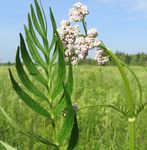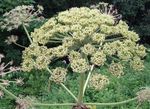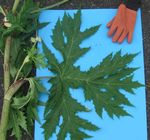Identification of Giant Hogweed
←
→
Page content transcription
If your browser does not render page correctly, please read the page content below
Identification of Giant Hogweed Giant hogweed is an introduced plant species in New Brunswick. Currently, there are very few confirmed locations where this plant is growing in the province. The majority are associated with a gardener who planted giant hogweed, which subsequently spread by unmanaged seed production. Giant hogweed is highly competitive due to its vigorous early-season growth, tolerance of full shade, and its ability to withstand flooding. Because of its large size and rapid growth, it can quickly dominate invaded areas and substantially reduce the amount of suitable habitat available for native plants and wildlife. In addition, this plant can cause potential human health issues. Giant hogweed sap contains toxins that, after exposure to sunlight, can cause significant dermatitis on sensitive individuals. Temporary blindness can also be caused by exposure of the eyes to the sap. Many plants within New Brunswick are similar in appearance to giant hogweed, most belonging to the Apiaceae or carrot family. Proper identification is essential to manage any plant species. Some of the most commonly occurring species with similar appearance are listed below, with information to aid in proper identification. Giant Hogweed Giant hogweed (Heracleum mantegazzianum, Berce du Caucase) is a member of the Apiaceae family. It typically grows very tall, from 1.5 to 5 metres in height. Its leaves are shiny and large, with very coarse and serrated leaf edges, like a jagged saw edge. The stems are very hairy, bristly and covered with purple spots or blotches. When mature, the plant produces flowers that form a large umbrella shape, up to 1.5 metres in diameter. These are made up of a large number of smaller umbrella-like clusters, each composed of over 50 stalked flower clusters. Giant hogweed is currently only found in a few localized areas in New Brunswick associated with a garden escape. Revised 2020 Agriculture, Aquaculture and Fisheries
Cow Parsnip
Cow parsnip (Heracleum maximum, Berce laineuse) is another member of the Apiaceae family and
is a native species in New Brunswick. It is typically shorter than giant hogweed, and is about 1-3
metres tall. The leaves of cow parsnip are typically smaller, longer stalked, less shiny and less
toothed as compared to giant hogweed. The stems of cow parsnip are more wooly hairy and are
usually more plain green. The flat-topped or umbrella shaped flowers are typically much smaller
than giant hogweed (up to 1 m wide) and are made up of far fewer stalked flower clusters (typically
15-30). Cow parsnip is common in moist to wet soils in a wide variety of habitats throughout the
province. Slight dermatitis can result from contact with this plant, but it typically causes much less
severe symptoms than giant hogweed.
Hogweed
Hogweed (Heracleum sphondylium, Berce commun) is a
much less common member of the Apiaceae family, but
this introduced species it also found in New Brunswick. It
is shorter than giant hogweed, usually about 1-2 metres
tall (rarely over 3 metres), and this difference in height is
often the easiest way to differentiate the two hogweed
species. This character is more reliable when large
patches provide a good indication of average height. The
leaves of hogweed are typically smaller, less toothed and
are more regularly divided (pinnate) as compared to giant
hogweed. The stems are typically hairy. The flowers are
typically much smaller than giant hogweed (rarely more
than 20 cm wide) and are made up of far fewer stalked
flower clusters (typically 15-45). Although hogweed is
rare in New Brunswick, it can form dense colonies of
plants when it becomes established in an area. Slight
dermatitis can result from contact with this plant, but it
typically causes much less severe symptoms than giant
hogweed.
Agriculture, Aquaculture and FisheriesAngelica
Angelica (Angelica sylvestris, A.
atropurpurea, A. lucida, Angélique) are
similar members of the Apiaceae family.
These plants are typically 1-2.5 metres tall
with large, compound leaves made of
smaller leaflets that are relatively finely
toothed, often rounded or elliptical in
outline. The stems are usually smooth and
can be purplish in colour. The flower heads
are round in appearance and much smaller
than giant hogweed flower heads.
Woodland angelica (A. sylvestris) is an
introduced and invasive species more
common throughout the Saint John River
valley in wet, weedy habitats. Seacoast
angelica (A. lucida) and purple Alexanders
(A. atropurpurea) are native species which
more commonly occur in coastal areas and
in the northern interior, respectively.
Angelica may cause slight dermatitis.
Wild Parsnip
Wild parsnip (Pastinaca
sativa, Panais sauvage) is
another member of the
Apiaceae family. This plant
is typically much shorter,
only growing to 0.5 to 1.5
metres in height. The
leaves are pinnately
compound, with sharp
teeth that can typically be
misshapen. This plant is
more branched than the
other members of this
family and has very
distinctive yellow flowers.
Wild parsnip is an
introduced species and is common along roadsides
throughout New Brunswick. The sap of this plant can cause a
poison ivy-like reaction in sensitive individuals, most
commonly noticed following whipper-snipping plants while not
wearing proper protection.
Agriculture, Aquaculture and FisheriesValerian
Valerian (Valeriana officinalis, Valériane officinale) is a member of a different plant family, the
Valerianaceae. Valerian typically grows to a height of 1 to 2 metres. Its leaves are pinnately
divided much like wild parsnip,
but the individual leaf segments
are much longer than parsnip.
The mature flowers are much
more clustered than the
Apiaceae and can be white to
purple in colour when mature.
The seeds of valerian are
similar to dandelion seed and
seed can be the easiest way to
correctly identify this plant.
Valerian is a highly invasive
species occurring most
commonly through the southern
region of New Brunswick.
Conclusion
Giant hogweed can present ecological and human health concerns, but luckily is not widespread in
New Brunswick. There are many plants which are similar in appearance to giant hogweed, most of
which do not cause the same level of concern. Proper identification of the plant in question is key
to proper management of any weed issue. For more information on giant hogweed, please refer to
the following websites of the Office of the Chief Medical Officer of Health, WeedInfo.ca or the IPM
Image database. You may also send a message to the New Brunswick Invasive Species Council.
Agriculture, Aquaculture and FisheriesYou can also read



























































